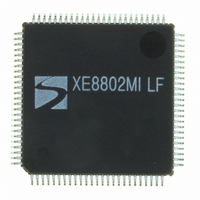XE8802MI035LF Semtech, XE8802MI035LF Datasheet - Page 4

XE8802MI035LF
Manufacturer Part Number
XE8802MI035LF
Description
IC DAS 16BIT FLASH 8K 100-LQFP
Manufacturer
Semtech
Datasheet
1.XE8802MI035LF.pdf
(193 pages)
Specifications of XE8802MI035LF
Applications
Sensing Machine
Core Processor
RISC
Program Memory Type
FLASH (22 kB)
Controller Series
XE8000
Ram Size
1K x 8
Interface
SPI, UART
Number Of I /o
36
Voltage - Supply
2.4 V ~ 5.5 V
Operating Temperature
-40°C ~ 85°C
Mounting Type
Surface Mount
Package / Case
100-LQFP
For Use With
XE8000MP - PROG BOARD AND PROSTART2 CARD
Lead Free Status / RoHS Status
Lead free / RoHS Compliant
Available stocks
Company
Part Number
Manufacturer
Quantity
Price
Company:
Part Number:
XE8802MI035LF
Manufacturer:
TI
Quantity:
8 700
- Current page: 4 of 193
- Download datasheet (2Mb)
XE8802 Sensing Machine Data Acquisition MCU
with ZoomingADC™ and LCD driver
1.1 Top schematic
The top-level block schematic of the circuit is shown in Figure 1-1. The heart of the circuit consists of the
Coolrisc816 CPU core. This core includes an 8x8 multiplier and 16 internal registers.
The bus controller generates all control signals for access to all data registers other than the CPU internal
registers.
The reset block generates the adequate reset signals for the rest of the circuit as a function of the set-up contained
in its control registers. Possible reset sources are the power-on-reset (POR), the external pin NRESET, the
watchdog (WD), a bus error detected by the bus controller or a programmable pattern on Port A. Different low
power modes are implemented.
The clock generation and power management block sets up the clock signals and generates internal supplies for
different blocks. The clock can be generated from the RC oscillator (this is the start-up condition), the crystal
oscillator (XTAL) or an external clock source (given on the XIN pin).
The test controller generates all set-up signals for different test modes. In normal operation, it is used as a set of 8
low power data registers. If power consumption is important for the application, the variables that need to be
accessed frequently should be stored in these registers rather than in the RAM.
The IRQ handler routes the interrupt signals of the different peripherals to the IRQ inputs of the CPU core. It allows
masking of the interrupt sources and it flags which interrupt source is active.
Events are generally used to restart the processor after a HALT period without jumping to a specified address, i.e.
the program execution resumes with the instruction following the HALT instruction. The EVN handler routes the
event signals of the different peripherals to the EVN inputs of the CPU core. It allows masking of the interrupt
sources and it flags which interrupt source is active.
The Port B is an 8-bit parallel IO port with analog capabilities. The URST, UART, PWM and CMPD block also
make use of this port.
The instruction memory is a 22-bit wide flash or ROM memory depending on the circuit version. In case of the
ROM version, the VPP and NFASTREAD pins are not used. ROM versions have 8k instruction memory. Flash
versions have 8k or 4k instruction memories depending on the selected operation speed.
The data memory on this product is a 1024 byte SRAM.
The Acquisition Chain is a high-resolution acquisition path with the 16+10 bits ZoomingADC™. The VMULT
(voltage multiplier) powers a part of the Acquisition Chain.
The SPI is a serial interface with a master or slave configuration capability. When unused, the 4 SPI pads can be
used as 4-bit wide general-purpose I/O port.
The port A is an 8 bit parallel input port. It can also generate interrupts, events or a reset. It can be used to input
external clocks for the timer/counter/PWM block.
The Port D1 and the Port D2 are two general-purpose 8 bit parallel I/O ports.
The LCD driver can support a direct drive display (up to 32 segments), or multiplex 1/2, 1/3, 1/4 displays (up to 120
segments). The driver contains an on chip low-power voltage generation device VGEN. The LCD lines can be used
as additional I/O pins.
The USRT (universal synchronous receiver/transmitter) contains some simple hardware functions in order to
simplify the software implementation of a synchronous serial link.
© Semtech 2006
www.semtech.com
1-2
Related parts for XE8802MI035LF
Image
Part Number
Description
Manufacturer
Datasheet
Request
R

Part Number:
Description:
EVALUATION BOARD
Manufacturer:
Semtech
Datasheet:

Part Number:
Description:
EVALUATION BOARD
Manufacturer:
Semtech
Datasheet:

Part Number:
Description:
VOLTAGE SUPPRESSOR, TRANSIENT SEMTECH
Manufacturer:
Semtech
Datasheet:

Part Number:
Description:
HIGH VOLTAGE CAPACITORS MONOLITHIC CERAMIC TYPE
Manufacturer:
Semtech Corporation
Datasheet:

Part Number:
Description:
EZ1084CM5.0 AMP POSITIVE VOLTAGE REGULATOR
Manufacturer:
Semtech Corporation
Datasheet:

Part Number:
Description:
3.0 AMP LOW DROPOUT POSITIVE VOLTAGE REGULATORS
Manufacturer:
Semtech Corporation
Datasheet:

Part Number:
Description:
Manufacturer:
Semtech Corporation
Datasheet:

Part Number:
Description:
RailClamp Low Capacitance TVS Diode Array
Manufacturer:
Semtech Corporation
Datasheet:

Part Number:
Description:
Manufacturer:
Semtech Corporation
Datasheet:

Part Number:
Description:
Manufacturer:
Semtech Corporation
Datasheet:

Part Number:
Description:
Manufacturer:
Semtech Corporation
Datasheet:

Part Number:
Description:
Manufacturer:
Semtech Corporation
Datasheet:











